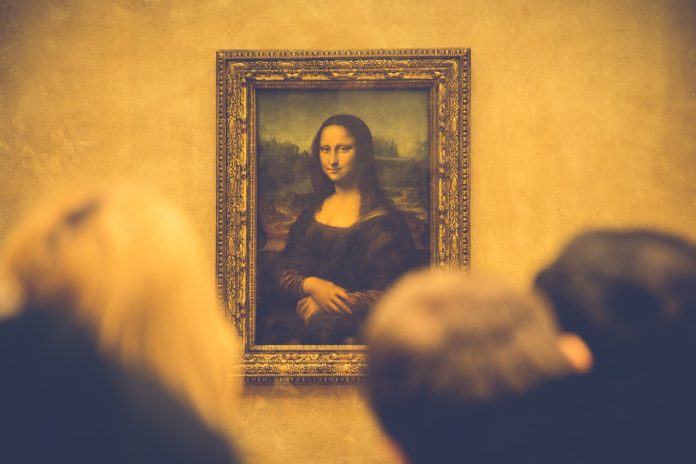Leonardo da Vinci’s masterpiece, the Mona Lisa, hangs in the Louvre Museum in Paris. This painting has been a subject of fascination since the 16th century. Its charm and mystery have attracted viewers ever since the portrait was painted.
Leonardo scholars know that there is a second painting of the same subject, equally beautiful and enigmatic. This earlier painting is sometimes known as the Isleworth Mona Lisa. This article will explore the history of the earlier Mona Lisa, tracing its known movements and offering scholarly thoughts on its provenance.
Commission of the Original Painting
In or around 1503, Florentine merchant Francesco del Giocondo commissioned a portrait of his wife Lisa. Born in 1487 outside Florence, Lisa del Giocondo was the mother of six children. Her husband was entering a period of prosperity. Having a master artist like Leonardo paint a portrait of his wife was an impressive status symbol.
(Source: Big Book, Introduction and Why Lisa)
Characteristics of the Painting
The earlier Mona Lisa is an early sixteenth-century oil on canvas. The subject is a dark-haired young woman who bears a strong resemblance to the subject of the Louvre Mona Lisa and is thought to be a portrait of the same woman painted at a significantly younger age. Both paintings share a three-quarter pose with the head tilted forward and the hands crossed.
The earlier painting features two flanking columns and a sketched-in background. Most contemporary accounts of this painting note that it was left unfinished.
Contemporary Accounts
While Leonardo worked on the earlier Mona Lisa in his studio in Florence, many contemporary artists and historians were witnesses to its creation. The famous artist Raphael completed a pen-and-ink drawing of the painting in 1504, prominently featuring the columns in the original work.
In 1914, Paul Konody, a well-known critic, described the Raphael sketch in context. ”…There is, in the collection of old master drawings at the Louvre an original pen drawing by Raphael, which is reproduced in Muntz’s great work on Leonardo, and which is generally admitted to be a memory sketch by Raphael of Leonardo’s ‘Mona Lisa’. Now this memory sketch is framed at both sides by two columns of which no trace is found in the Paris ‘Mona Lisa’. These columns appear in the identical place in the Earlier Isleworth picture and are of immense value in the harmonious balance of the composition.”
This sketch perplexed art historians who were not aware of the existence of the earlier Mona Lisa. When the earlier Mona Lisa became well-established, art experts began to accept that the Raphael copy was referring to it and not to the Louvre Mona Lisa.
(Source: Big Book, page 17-18)
Another contemporary account of the painting’s creation comes in the writings of Agostino Vespucci, secretary to the Second Chancellor of the Signoria in Florence, Niccolo Machiavelli. Vespucci noted in the margins of a work by Cicero that Leonardo was at work on a portrait of Lisa del Giocondo while he was planning his major fresco, the Battle of Anghiari. This “Heidelberg document” recently came into view, helping to cement the creation of the earlier Mona Lisa to the early 1500s in Florence.
(Source: Big Book, page 7)
Leonardo’s Practice of Creating Two Versions
Creating two versions of a similar subject was one of Leonardo’s most documented practices. Together with the Mona Lisa paintings, he also created multiple versions of the Virgin and Child with St. Anne and the Madonna of the Yarnwinder.
Creating multiple versions of the same subject enabled the great master to test out certain painting and drawing techniques. It also allowed him to disseminate some of his ideas to his followers more easily.
The Isleworth Mona Lisa Throughout History
Leonardo died in May 1519, possibly suffering from a stroke. Upon his death, the earlier Mona Lisa was most likely transferred to his student Salai. At Salai’s death, the painting was listed among his possessions.
After Salai’s death, the painting appears in two contemporary art histories. Giorgio Vasari describes the unfinished portrait of Lisa del Giocondo in his 1550 volume, The Lives of the Most Excellent Italian Painters, Sculptors and Architects. In 1584, Gian Paolo Lomazzo describes two similar yet separate paintings by Leonardo, called La Gioconda and Mona Lisa.
Alberto Angela writes: “Here we see the two columns, like in Raphael’s sketch, as well as the eyebrow lines that do not appear in the Louvre Mona Lisa. In addition, the model appears to be younger and the background is just sketched in. Based on this, it has been argued that we are not talking of a copy, as a copyist would attempt to reproduce the original faithfully, and here the background is completely different.”
(Source: Alberto Angela translation)
Rediscovery
In 1778, the painting was acquired by an English nobleman named James Thomas Benedictus Marwood. The painting was brought back from Italy and displayed in his Somerset manor. The painting stayed in Somerset until 1858 when it was auctioned at Avishays House.
In 1913, Hugh Blaker, an art connoisseur and curator, rediscovered the painting in Somerset. Blaker buys the painting and transports it to his studio in Isleworth, London, giving the painting its name.
Critical study of the Isleworth Mona Lisa began in the early 20th century. John R. Eyre was instrumental in returning the painting to the front page in the art world, where consensus began to build among experts that the earlier Mona Lisa was a genuine work of Leonardo.
Current Status
Presently, the painting is owned by the Mona Lisa Foundation, dedicated to preserving it and to attributing it to the great master. The Foundation has been instrumental in producing historical and scientific studies that place the painting firmly in Leonardo’s canon.
Two Distinct Paintings
This beautiful painting does bear a significant resemblance to the painting hanging in the Louvre in Paris, but its history has taken more twists and turns. When we trace the original painting’s movements through history, we see its importance in Leonardo’s canon.
Find a Home-Based Business to Start-Up >>> Hundreds of Business Listings.
















































